Arm Announces Neoverse N1 & E1 Platforms & CPUs: Enabling A Huge Jump In Infrastructure Performance
by Andrei Frumusanu on February 20, 2019 9:00 AM ESTE1 Implementation & Performance Targets
The Neoverse E1 CPU being a small CPU core aimed at cost-effective and dense implementation naturally needs to be quite small, as well as power efficient.
Implemented on a 7nm process, Arm physical design team is able to get an E1 CPU core with 32KB L1 and 128KB L2 cache down to 0.46mm² - all while reaching a high clock of 2.5GHz and a power consumption of 183mW. The higher clock was a surprise as it is quite notably higher than what we’ve seen vendors achieve on the A55 – although we are talking about different implementation targets.
Arm envisions the most popular implementations of the E1 to be found in lower power edge applications. At the lower end, ranging from 8-16 cores would be a good for wireless access points and gateways, delivering data throughputs in the 10-25Gbps rang. A tier up we would see 16-32 core designs in use-cases such as edge data aggregation deployments, achieving data rates in the 100’s of Gbps.
The Neoverse E1 reference design that Arm offers and sees as being the most popular “sweet-spot” is based on a 16 core design. Here we have to clusters of 8 cores in a small CMN-600 2x4 mesh network, allowing for system cache options as well as integration of possible additional third-part IP. The envisioned memory system would be a 2-ch DDR4 configuration.
Such as SoC would have a power consumption of less than 15W, of which less than 4W would actually be used by the CPU cores. SPECint2006 rate scores would come in at 153 – which given the actual size and power consumption of the platform is quite impressive. The system would also be capable of 25Gb/s network throughput, enabled solely by a software transport layer (Meaning no hardware acceleration).
On a per-core comparison to the Cortex A53 and A55, the new E1 CPU would again offer significant throughput performance benefits, but also very importantly it would represent an efficiency boost compared to its predecessors (ISO process comparison).


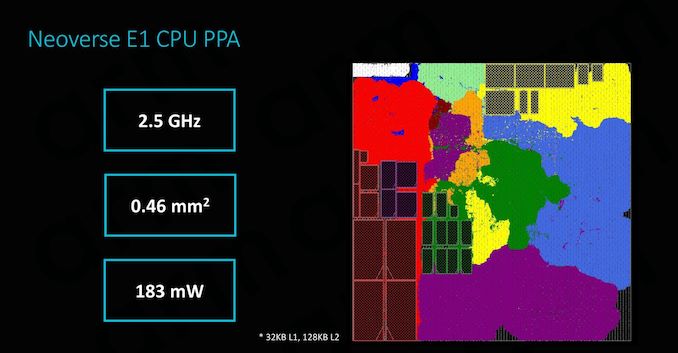
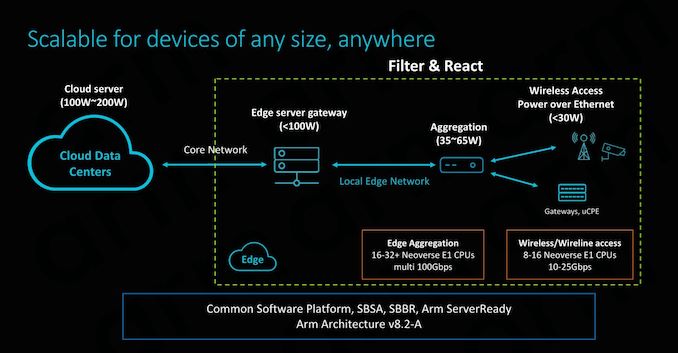
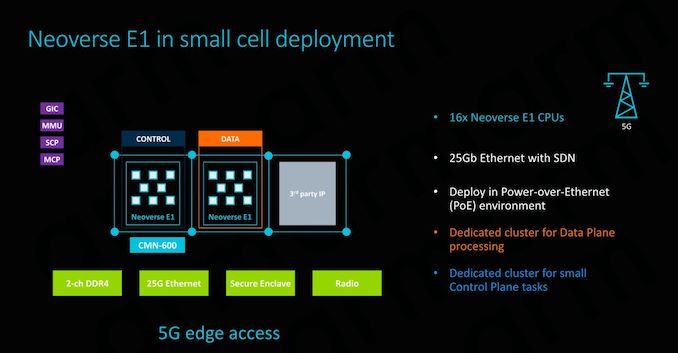
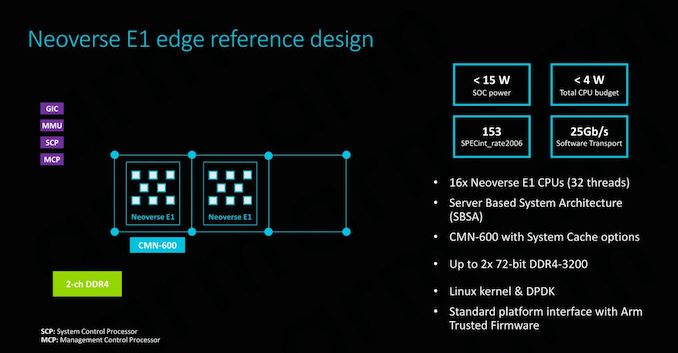
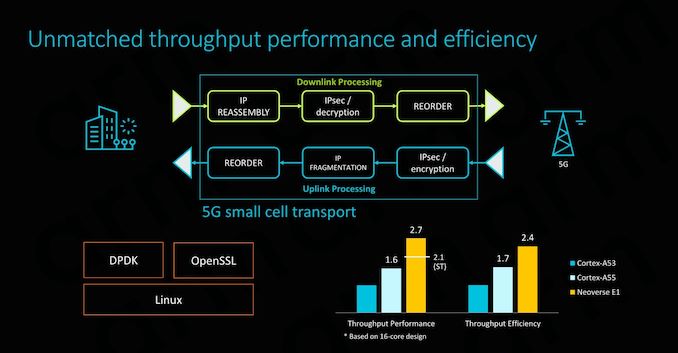
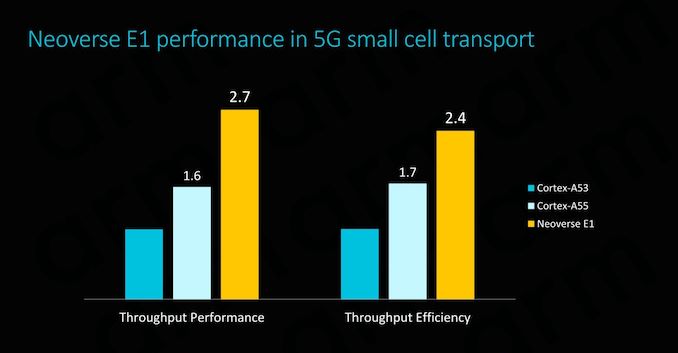








101 Comments
View All Comments
surt - Thursday, February 21, 2019 - link
That raw power comes at a .... power cost. And as soon as you try to start z-stacking your cpus that power is going to be the most important factor.peevee - Tuesday, February 26, 2019 - link
"The future is way more related to modularity than the chip architecture."Debatable. Both ARM and x64 are essentially the same in terms of efficiency if the same levels of performance are required. A breakthrough can only come from in-memory computing, which neither ARM nor x64 can sustain for many reasons.
rahvin - Thursday, February 21, 2019 - link
ARM is not "more efficient at every level". That's just plain fanboi BS. The architecture is the least important aspect of any processor these days.ARM processors were traditionally designed for power efficiency above all else, now that Intel is designing down for efficiency and ARM is designing up for power there will likely be some real competition but so far ARM has not demonstrated that they can provide equivalent power for the same power budget at the high end and Intel has had difficulty matching the lower power budget and performance on the low end (though this is likely due to them wishing to avoid cannibalizing higher end products with performant low power versions).
As ARM tries to enter the server market we'll finally see if they can provide something equivalent, but it's not been a hopeful showing given that all but one ARM server design has been canceled and it's not equivalent to an x86 server processor of the same character in either power or performance.
Wilco1 - Thursday, February 21, 2019 - link
Today you can buy Arm-based servers like Operon A1100, Centriq, ThunderX, ThunderX2, eMAG and HiSilicon. The first Arm supercomputer entered the TOP500 list recently, and Fujitsu has prototypes of their Post-K computer. You can buy Arm compute time from several cloud vendors today, including AWS. That all adds up to one Arm server in your book?rahvin - Thursday, February 21, 2019 - link
ThunderX is gone, displaced by the ThunderX2 which is the Centriq processor after it was abandoned by it's creator. eMAG, A1100 and the HiSilicon Last I saw are all canceled.Commercially you can buy one ARM server, the ThunderX2. Go ahead, TRY to buy one.
Wilco1 - Thursday, February 21, 2019 - link
How could you be so clueless? ThunderX2 is based on Vulcan made by Broadcomm, no relation with Centriq at all. ThunderX is still being used and sold. Centriq is still being sold, a few months ago Gigabyte announced a brand new motherboard for it. eMAG is just announced. HiSilicon/Huawei has 2 generations of Arm servers already and is working on several more. That's the only one that isn't for sale outside of China according to AnandTech.What's next? Are you going to tell us that Arm servers did not beat Xeon and SkyLake in various benchmarks, eventhough the evidence was published in an article on AnandTech?
rahvin - Thursday, February 21, 2019 - link
Your right I confused the Vulcan and the Centriq. The Centriq is dead, the design teams gone,and there is no plan to even spin the silicon from what I've seen. Qualacom abandoned the product under threat from an activist investor. Yea there was a motherboard at CES but that doesn't mean anything at all and there is literally no way to buy one.ThunderX is depreciated (show me where you can buy one, they depreciated the silicon over a year ago, there may still be some inventory out there but I seriously doubt it), ThunderX2 is available, and from everything I saw it's awful. The best work case was as a nginx master server because the compute capacity was so awful. Basically you need a workload with a lot of threads and no actual work to even make it worth anything at all, especially considering the price.
The Huawei junk is a nonstarter, you can't buy it anywhere but China that I've seen and it's not exactly flying off the shelves either. I've seen more ARM servers announced and canceled a year later than any that made it off the shelves into an actual product. So there is an eMag, that's great show me where you can buy it.
That's my point, you can't buy them, other than the ThunderX2 or the Huawei if you want to go to china to get it. The Arm server has been a flash in the pan and I have no doubt it will continue to be so.
FunBunny2 - Wednesday, February 20, 2019 - link
one has to wonder: given the existence of C compilers for any ISA, and thus *nix OS for said ISA, when (or already?) will the maths dictate both the 'optimal' ISA and underlying microarch? both, after all, are just maths optimization problems. to some delta, there is a unique solution.zmatt - Wednesday, February 20, 2019 - link
Baring any major design flaws there shouldn't really be a difference in theoretical performance between ISAs. Its important to note that the ISA isn't the actual logic of the chip, its better thought of as a paper standard a given chip needs to conform to if it wants to be binary compatible. The real determination in performance is the microarchitecture. People conflate this with ISA a lot because they are both architectures but the Micro arch is what describes the actual logic design in the circuit. That is what Intel and AMD apply codenames to. So things like Skylake, Thunderbird, Cortex A53 etc are micro architectures.Wilco1 - Wednesday, February 20, 2019 - link
There certainly are differences between ISAs which cannot be overcome with micro-architecture no matter how much money, power or transistors you throw at it. Given equal resources, the best possible implementations of various ISAs will exhibit major performance differences.